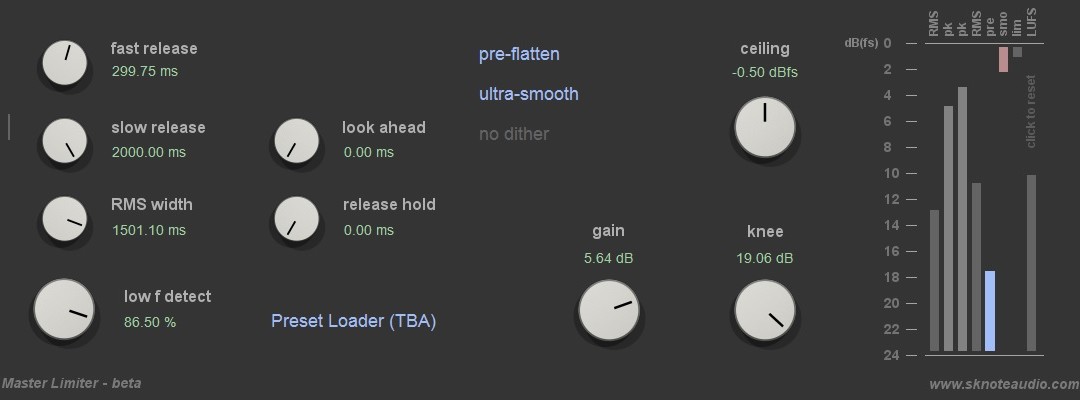Features:
- Fast release and Slow release knobs. They set the extremes for a dinamically modulated release time constant. The faster the release, the higher the perceived volume, the easier it will distort (mainly on low frequencies). Set them to useful extremes depending on the source material.
- RMS width knob. This is related to how the release time is modulated between the two values set by previous knobs. Set it to low values for faster average release, to high values for slow average release time.
- Low f detect knob. Fast release timing could make lowest frequencies distort. This control takes into account the results of a continuous analysis of the spectral content and increases the release time on low range decays.
- Look ahead knob. Delays the audio path so that the internal sidechain path works ahead of time and can trigger gain reduction a few milliseconds before the peak actually rises. Useful to get a more effective limiter action and also a more transparent sound, actually triggering the gain reduction a bit before the peak comes in, leaving its shape untouched.
- Release hold knob. Inserts a delay when the gain control passes from attenuating to recovering. Useful also with the previous control (look ahead), for example trigger a gain reduction action 20ms before a peak comes (by setting a 20ms look ahead time) and keep the gain reduction locked to its stronger value until the peak has passed. Setting the same values for look ahead and release hold controls could be the best choice.
- Gain knob. An input gain. Push against all the stages of the system.
- Ceiling knob. The maximum absolute ceiling of the brickwall limiter. Nothing passes beyond this value.
- Knee knob. The limiter can have different values for its knee, the curve that crossfades between no action and max action (ceiling reached). This value is compensated so that the max absolute reachable level is alwais ceiling. The net effect is that an increase of the knee value causes an increase of lowest input levels’ output level (upward compression).
- Pre-process menu. Includes a Smooth option. Its action on the spectrum improves the general balance, increasing the perceived level and open-ness of the sound.
- Smooth menu. An option for a pre-processing stage, before the sound reaches the input of the limiter. It inserts a special series of processing stages that can better prepare the signal to limiter’s action.
- Dithering menu. Several options for a dithering (last) stage, useful when reducing the resolution, e.g. passing from floating point to 16 bit fixed point. Currently disabled in the beta version.
Metering. A complete set of metering tools is included. Left to right:
- RMS and Peak output levels (Left and Right channels).
- Pre-processing action.
- Smoothing action.
- Limiter action.
- Integrated LUFS measurement. It computes the integrated value from the reset or start to the current time. Includes a gate section so it doesn’t include silence regions that can affect the measure. Click on it to reset the integral value.To get the value for a song: position to the start of the song. Click on the meter. Start the song and wait until it completes. Hit stop and get the resulting integral from the meter.
